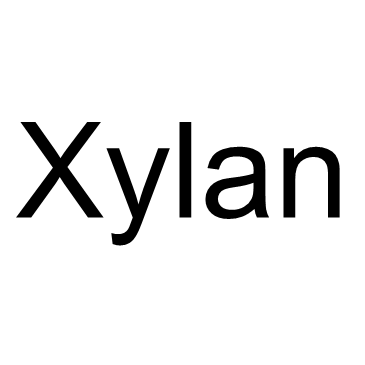Xylan

Xylan structure
|
Common Name | Xylan | ||
|---|---|---|---|---|
| CAS Number | 9014-63-5 | Molecular Weight | 150.13000 | |
| Density | N/A | Boiling Point | N/A | |
| Molecular Formula | C5H10O5 | Melting Point | N/A | |
| MSDS | USA | Flash Point | N/A | |
|
Leaf-cutter ant fungus gardens are biphasic mixed microbial bioreactors that convert plant biomass to polyols with biotechnological applications.
Appl. Environ. Microbiol. 81 , 4525-35, (2015) Leaf-cutter ants use plant matter to culture the obligate mutualistic basidiomycete Leucoagaricus gongylophorus. This fungus mediates ant nutrition on plant resources. Furthermore, other microbes living in the fungus garden might also contribute to plant dige... |
|
|
The bZIP Transcription Factor HAC-1 Is Involved in the Unfolded Protein Response and Is Necessary for Growth on Cellulose in Neurospora crassa.
PLoS ONE 10 , e0131415, (2015) High protein secretion capacity in filamentous fungi requires an extremely efficient system for protein synthesis, folding and transport. When the folding capacity of the endoplasmic reticulum (ER) is exceeded, a pathway known as the unfolded protein response... |
|
|
Deletion of homologs of the SREBP pathway results in hyper-production of cellulases in Neurospora crassa and Trichoderma reesei.
Biotechnol. Biofuels 8 , 121, (2015) The filamentous fungus Neurospora crassa efficiently utilizes plant biomass and is a model organism for genetic, molecular and cellular biology studies. Here, a set of 567 single-gene deletion strains was assessed for cellulolytic activity as compared to the ... |
|
|
Purification, molecular cloning, and enzymatic properties of a family 12 endoglucanase (EG-II) from fomitopsis palustris: role of EG-II in larch holocellulose hydrolysis.
Appl. Environ. Microbiol. 74(18) , 5857-61, (2008) A family 12 endoglucanase with a molecular mass of 23,926 Da (EG-II) from the brown-rot basidiomycete Fomitopsis palustris was purified and characterized. One of the roles of EG-II in wood degradation is thought to be to loosen the polysaccharide network in c... |
|
|
Xylan structure, microbial xylanases, and their mode of action.
World J. Microbiol. Biotechnol. 8 , 353, (1992) Xylans, the major portion of the hemicellulose of plant cell walls and grasses, are heteropolymers consisting principally of xylose and arabinose. Microbial xylanases with different multiplicities and properties are reported. Most studies on the mode of actio... |
|
|
Xylanases of Bacillus spp. isolated from ruminant dung as potential accessory enzymes for agro-waste saccharification.
Lett. Appl. Microbiol. 60(5) , 456-66, (2015) Polysaccharide hydrolase producing bacteria were isolated for biomass saccharification step in two-step bioethanol production. Xylanolytic bacteria were found to be common in ruminant dung. Seven Bacillus dung isolates exhibited high xylanolytic activity; thr... |
|
|
Purification and some properties of endo-1,3-beta-D-xylanase from Pseudomonas sp. PT-5.
Agric. Biol. Chem. 54(4) , 921-6, (1990) An endo-1,3-beta-D-xylanase (1,3-beta-D-xylan xylanohydrolase, EC 3.2.1.32) was purified from the culture fluid of Pseudomonas sp. PT-5 by ammonium sulfate fractionation, DEAE-Sepharose CL-6B, Toyopearl HW-50S, and Butyl-Toyopearl 650 M column chromatography.... |
|
|
Characterization of a modular enzyme of exo-1,5-alpha-L-arabinofuranosidase and arabinan binding module from Streptomyces avermitilis NBRC14893.
Appl. Microbiol. Biotechnol. 80 , 399-408, (2008) A gene encoding an alpha-L-arabinofuranosidase, designated SaAraf43A, was cloned from Streptomyces avermitilis. The deduced amino acid sequence implies a modular structure consisting of an N-terminal glycoside hydrolase family 43 module and a C-terminal famil... |
|
|
D-xylose isomerase from a marine bacterium, Vibrio sp. strain XY-214, and D-xylulose production from β-1,3-xylan.
Mar. Biotechnol. 14(1) , 10-20, (2012) The xylA gene from a marine bacterium, Vibrio sp. strain XY-214, encoding D-xylose isomerase (XylA) was cloned and expressed in Escherichia coli. The xylA gene consisted of 1,320-bp nucleotides encoding a protein of 439 amino acids with a predicted molecular ... |
|
|
Novel carbohydrate-binding module of beta-1,3-xylanase from a marine bacterium, Alcaligenes sp. strain XY-234.
J. Bacteriol. 184(9) , 2399-403, (2002) A beta-1,3-xylanase gene (txyA) from a marine bacterium, Alcaligenes sp. strain XY-234, has been cloned and sequenced. txyA consists of a 1,410-bp open reading frame that encodes 469 amino acid residues with a calculated molecular mass of 52,256 Da. The domai... |